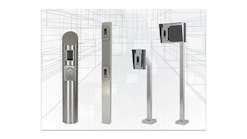In many cases, an electronic access control (EAC) installation requires door hardware to be powered through a building’s Ethernet connection. You now are in the select group who are on a “need to know” basis about an important power source.
Power over Ethernet (PoE) appears intimidating, but it’s increasingly plug and play. This article will explain how it works, where you must have it, what questions you should ask and what tools are necessary for the job. If the total power budget for the opening is within the range of the available PoE source, you can consider this option.
The Basics
Three things will lead you to consider PoE. First, you might not have a reliable electrical power source nearby. Second, your hardware might have to communicate with a controller via the building’s in-house Ethernet. The third reason is that PoE might provide a good backup source for your equipment. Riding on the existing building network can be the difference between winning and losing a job.
Exterior gates, remote warehouse doors, external cameras, emergency call stations, intercoms, speakers and outdoor radios are common applications. PoE also can provide a trickle-charge, or backup, for critical operations.
In recent years, we’ve seen quite a movement to low power consumption for electrified locks, exit devices, strikes, magnetic locks, LED emergency lighting and cameras. This allows these devices to be powered over the Ethernet as well as provide energy savings. Several manufacturers offer locking devices that are in the 3- to 8-watt range — easily within the reach of the lowest Ethernet power. Other readers, links and controllers are moving into that range as well.
With respect to PoE, you should know some basic terminology:
- Power source equipment (PSE) is where the power originates.
- Endspan switches are the most common PSEs. These are the black boxes that control data flow to and from the IT department. PoE-enabled endspan switches allow the cabling to carry power as well as data.
- Midspan injectors add power into existing Cat 5 or higher cables if power isn’t supplied by the endspan switch.
- Splitters (or extractors) send power to non-PoE powered devices and send data to a separate input. This allows noncompliant equipment to upgrade to PoE.
- Powered device (PD) is your lock, camera, intercom, etc.
Power and data generally originate at the endspan switch in the IT department. If legacy non-PoE switches remain at the data center, power can be injected by a midspan device connected to a more convenient electrical outlet. Many of these run on either 120 or 240VAC. Midspan injectors range from inexpensive single-port models up to more-expensive multiport and gigabit injectors.
PoE-ready IEEE 802.3-rated controllers, readers, cameras, etc., have an internal circuit to negotiate power directly from the PSE. These powered devices display an IEEE standard. Power and data will be delivered from the Ethernet cable through an RJ45 jack.
Legacy designs that have non-PoE Ethernet communication will have a separate set of terminals for DC power input. These powered devices will have an RJ45 connection for data but no onboard circuit to negotiate power with the PSE. These devices will require a splitter to separate power and data.
Prominent OEMs, such as Cisco and Microchip, are safe and helpful domestic manufacturers of Ethernet gear. Altronix also is a reliable source, while lock suppliers, such as SDC, Securitron and ADI, package them as well.
How It Works
Ethernet wiring in buildings since the late 1980s will have four twisted pairs of copper wire (usually 24–26 awg). For some time, networks used only two of the four pairs. The extra two pairs carry the 48VDC power in what’s known as “Alternative B.”
As ever-higher data speeds required transmission on all four pairs, ghost power was sent over two pairs in an “Alternative A” mode. Continuing DC power demands led to all four pairs being used for data and power. This third mode is called 4PPoE (4 Pair PoE). Since 2003, the Institute of Electronics and Electrical Engineers (IEEE) has issued PoE standards that define classes of power produced at the origin and minimums delivered at 100 meters. Longer runs are likely to require repeaters.
Powered devices are assigned a class, dependent on how much power they require. When a connection is made, the power device sends its class to the PSE, so it can allocate the correct amount of power.Each port from the endspan switch or midspan injector will have a defined wattage available. Your controllers, readers and electromechanical hardware will have a rated maximum power consumption. Add up the watts required at the end of the line, and you have your power budget. Power budgets are critical.
Here’s the neat part: PoE devices that conform to IEEE standards are backward compatible and perform a startup handshake to protect against noncompliant devices, overloads, underpowering and incorrect installation. Equipment built under 802.3at or later standards also performs an “autoclass” function that tells the PSE what level of power is required. Connecting non-PoE devices into a PoE port won’t create a problem, because no power will be supplied.
Cat What?
Ethernet cable categories can be confusing, but a few basics can help you to ask the right questions on site. A cable’s category generally is printed on the cable, along with the bandwidth.
All current Ethernet data cabling will use the RJ45 eight-pin connector. Cat 6 connectors however, have vertically staggered wire-insertion holes for improved performance. Cat 6e and Cat 6a also will have a center spline that isolates twisted pairs. Cat 7 cabling will have an RJ45-compatible CG45 connector or, more often, a completely different TERA connector. Shielded cable will require shielded connectors. You won’t have to have Cat 6, but it’s useful to recognize it.
Cat 5 cabling has been around since the mid-1980s, but most of that has been replaced with Cat 5e (enhanced). Higher grades probably have no value for power delivery. Beware of budget cabling products that might have copper-clad aluminum wire. Copper wire is what you want.
Most current PoE-powered products require Cat 5e or higher cabling to provide a reliable data path for controllers or readers. Your primary concerns will be the power budget for the equipment you plan to control and the PoE compatibility of your products.
Tools
The amount of necessary tools for PoE jobs might be minimal, depending on your scope of work. In many cases, a certified systems integrator might handle the wiring, switches or injectors. You might have to provide (or request) splitters and possibly cabling from the Ethernet connection to the reader or controller. Stick with reliable brands, but don’t overspend on expensive equipment that won’t provide any benefit. Watch out for “good deals” that really aren’t. Costs might escalate rapidly beyond Cat 5e.
Platinum Tools is a premier domestic supplier of electronic service equipment and has a 115-page catalog of everything you possibly could use. Its ezEX Starter Kit provides basic RJ45 connectors and a slick Crimp Frame tool. The company’s PoE++ Tester allows quick tests of active data cables to simulate a powered device or test maximum power available from the PSE.
SARGENT and Corbin Russwin have a PoE Cable and Data Hinge Test Adaptor to troubleshoot connections from the Ethernet to the PoE lock assembly. The test tool quickly isolates lock, power or data issues.
Lock Options
PoE lock hardware options are increasing rapidly. Two connection options are available. PoE-ready equipment that has onboard logic can take data and power directly from the energized Cat 5 or higher cable. In the second case, legacy equipment that has RJ45 Ethernet connections but not the PoE logic can be powered via a splitter.
- SDC has developed an extensive line of low-power locks, electric strikes, maglocks, controllers and readers for IP-based EAC applications. The IP Pro line includes controllers, readers and low-current-draw locking devices. The IP Pro Splitter provides separate data and up to 24 watts of power for the controller and door hardware. The company provides considerable information and technical support.
- NAPCO’s Continental Access provides the uniVerse PoE Controller that handles two readers and one low-current lock. This connects with Alarm Lock Trilogy Networx products. The E-Access single-door controller is also a self-contained scalable EAC solution.
- Schlage AD-300 locks draw only 3 watts through PoE when connected via a splitter with a Mercury EP-1501 Intelligent Controller.
- BEST uses optional PoE to power the Wi-Q Wi-Fi portal gateway, which connects with battery-operated locking devices in the area.
- ASSA ABLOY’s companies also use PoE connections to their Aperio Wi-Fi gateways.
- Corbin Russwin and SARGENT have built low-energy PoE-enabled locks that pull only 3.84 watts. A PoE-ready EAC panel is built into each lock, which allows the device to make local decisions. The lock is wired through a raceway in the door using PoE cabling. This connection allows the customer to leverage existing IT infrastructure to add doors to their system without separate EAC panels.
- Open Options offers the PoE-ready NSC-200 (Mercury MR62e) that communicates with 802.3at or earlier PoE standards. The intelligent device makes local decisions and is scalable to 16 doors with the DController.
- Hartmann Controls produces a PoE-driven single-door controller in an over-door module. This can be stand-alone or a component of its Protector.net system.
- ASSA ABLOY Electronic Security Hardware brand Securitron has been active in the PoE market, with a number of products to support network connections. The AQE15 Midspan Injector provides 15 watts of power, while the AQE30 injects up to 30 watts of power to Ethernet lines. The AQE30E Extractor (splitter) separates the data and supplies up to 30 watts to non-PoE-ready controllers or locks.
Another interesting option for remote locations is Securitron’s solar-power kit. This package was designed for remote electric lock control where conventional power is impractical or not available. Solar panels that have 10- or 20-watt charging power are available, along with a solid-state controller, marine-rated terminals, the housing, a battery and wind-rated mounting assemblies.
Remember, if you have low-power EAC or locking hardware connecting to a building’s Ethernet, your project is a candidate for PoE energy. This is particularly true if electrical power isn’t handy. Check the power budget for your equipment and see what the IT department supplies (or doesn’t).
PoE is a developing technology that just might win you some good projects.
Cameron Sharpe, CPP, worked 30 years in the commercial lock and electronic access industry. [email protected]
Working with IT
When installing electronic access control, you should ask the customer’s IT department for their help and advice. This is their system, and they can be a great help. In some cases, they will guard their watts jealously, wishing no hookups. However, expanding their importance and budgets is seldom far from their minds. Stay humble and ask questions to get the most cooperation.
Here’s what you want to know:
- Does the building’s Ethernet run on Cat 5e cable or later?
- Do the endspan switches in the IT department provide PoE power?
- If so, which standard: af, at or bt?
- How much power is available at the locations where you wish to connect?
- What power budget does each reader, door, intercom or camera require?
Cameron Sharpe
Cameron Sharpe, CPP, worked 30 years in the commercial lock and electronic access industry. Contact him at [email protected].







